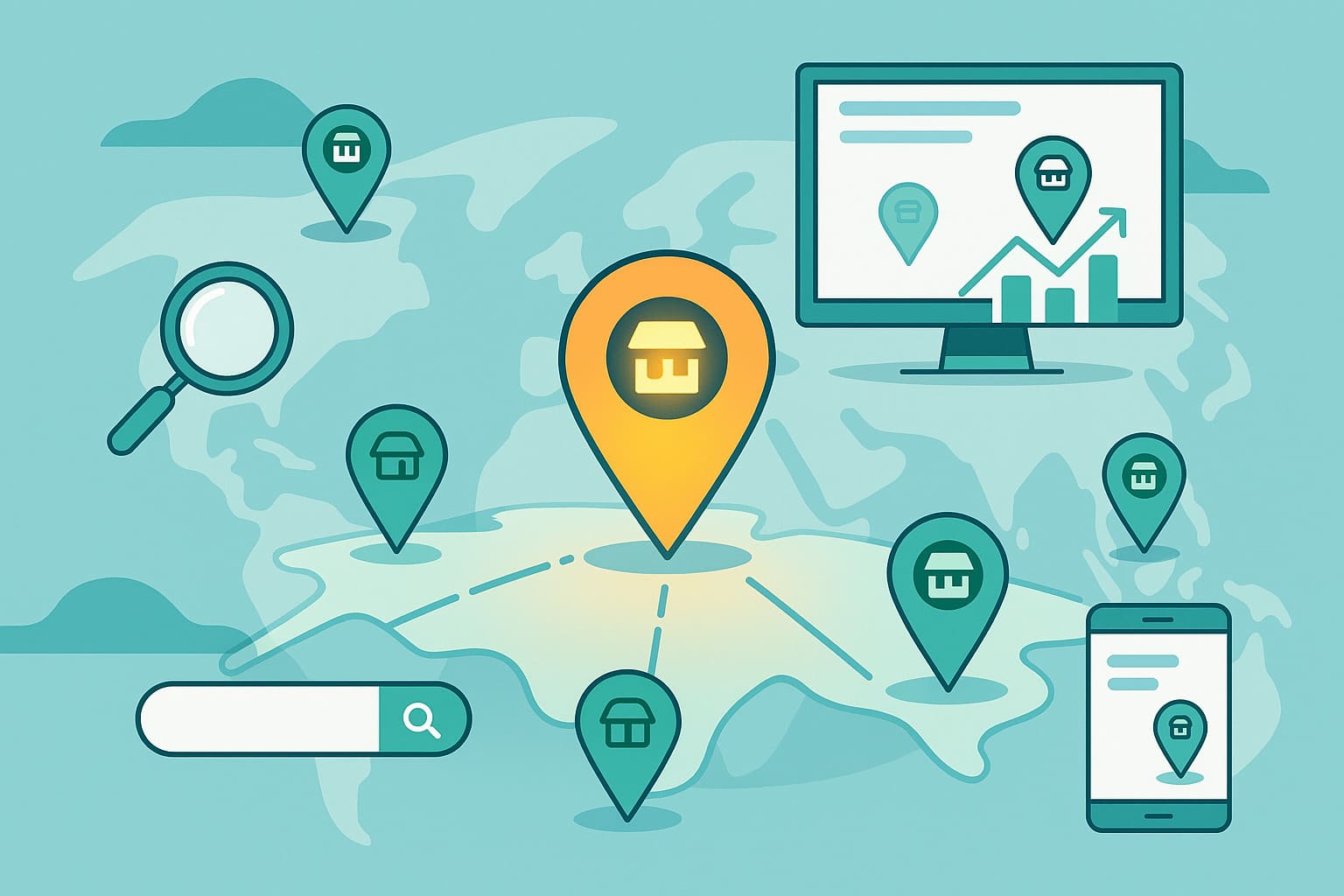If your business serves more than one location, showing up in local searches is not as easy as it sounds. A single website homepage is not enough. You need to show Google that you are active, trusted, and relevant in each place you serve.
That is where local SEO for multiple locations comes in.
Local SEO for multiple locations helps every branch rank in its own area. If someone searches for a plumber in Austin or salon in Miami, your business should be right there on top.
If people do not find you in their city, that location might as well not exist.
Local SEO is not just adding city names to your website. It is about building trust signals for each spot your business serves. You need real content for every location, correct phone numbers across directories, reviews for every branch, and a page structure that search engines understand.
In this guide, you will learn how to do local SEO for multiple locations step by step. This includes:
- Building clean, keyword-rich landing pages for every city
- Fixing NAP issues so Google sees the right address and number
- Setting up Google Business Profile for each location
- Using location-based schema markup to boost trust
- Getting real reviews that show up in search
- Earning local backlinks for better rankings
This is not a theory. These steps work for retail chains, clinics, service areas, and franchise businesses that want to grow fast across cities.
What Is Local SEO for Multiple Locations?
Local SEO for multiple locations means optimizing your website and listings so each branch ranks in its specific city or area. One page or listing cannot support several locations. Each branch must be treated like its own local business online.
This approach ensures that your New York location shows up in New York searches, your Chicago branch ranks in Chicago, and so on. It helps people nearby find the exact location that serves them.
To do this, create a unique landing page for each city, use city-based keywords, and set up a Google Business Profile for every branch. These steps make each location easier to discover on search engines and maps.
With this strategy, you increase visibility, drive local traffic, and grow business in every area you serve—one location at a time.
Key Differences Between Single and Multi-City SEO
Local SEO focuses on helping a single business location rank in its area. It works well for shops, clinics, or offices with just one address. You set up a Google Business Profile, optimize one page, and target local keywords for that one place.
Multi-location SEO goes further. It applies the same strategies to every branch of a business—but separately. Each location needs its own optimized page, local keywords, reviews, and map listing. You cannot treat five locations as one. Each one must be built and ranked like its own business.
Multi-location SEO approach is key for franchises, retail chains, service companies, and clinics with multiple branches. It helps people find the exact location closest to them—and helps your business grow in every area you serve.
“One local strategy per location. That’s how multi-location SEO wins.”
Quick Tips: Local SEO For Multiple Locations
To do local SEO for multiple locations, follow these steps:
- Create a unique page for each location on your website
- Use local keywords that include the city name
- Set up a Google Business Profile for every branch
- Keep NAP details (Name, Address, Phone) consistent everywhere
- Add LocalBusiness schema to each location page
- Get local reviews for each branch from real customers
- Build local backlinks from city-based websites
- Track performance using tools like Google Analytics and Search Console
Each location should be treated as its own online entity. This helps you rank better in city-specific searches and attract more local traffic.
Who Needs Local SEO for Multiple Locations?
Any business that serves customers from more than one physical place needs local SEO for multiple locations. If your business has two or more branches, offices, or service areas, this strategy is made for you.
Here are the types of businesses that benefit:
- Retail stores with outlets in different cities
- Clinics or hospitals with multiple branches
- Restaurants or food chains with dine-in locations
- Real estate agencies with city-specific offices
- Law firms operating in more than one region
- Fitness centers or gyms across towns
- Service-based businesses covering several areas
Even if you visit customers at home, like electricians or repair services, you still need to rank in each service area.
People search with city names or near me. If your business is not set up to show location-specific results, they will not find you.
Local SEO helps your customers see the right branch, the right page, and the right map pin every time.
Why Local SEO for Multiple Locations Matters
When people search online, they want fast answers near them. If your business has more than one location, each one needs to show up in local search. If not, your competitors will take the lead in that area.
Local SEO helps each branch rank in its own city. It makes sure your locations appear in map packs, voice search, and mobile results. When done right, it builds trust with search engines and customers in every area you serve.
Here is what happens when you do it well:
- People find your nearest branch easily
- Your local pages bring in more traffic
- Calls and visits increase without extra ads
- Search engines trust your brand across regions
- Reviews and backlinks grow for every location
This is how local visibility turns into real growth.
“One search. One city. One click. That is how location SEO brings business to your door.”
9 Steps to Do Local SEO for Multiple Locations
Local SEO for multiple locations is not just about adding city names to your site. Each location needs its own setup to rank in search. These 9 steps will help you build strong visibility for every branch, one city at a time.
Step #1 – Build a Clear Site Architecture
Good structure is the foundation of strong local rankings. Before you rank in search, you need a strong structure. Your website must clearly show that you have more than one location. Each branch should have its own page, and those pages must be easy to find for both users and search engines.
Start with a clean URL structure like:
- /locations/new-york
- /locations/chicago
- /locations/dallas
Each city should have its own landing page with helpful details. Make sure the main menu or footer links to all location pages. Also, use breadcrumbs so users can navigate easily.
This setup helps Google understand your site and index each location page the right way. It also gives every page the chance to rank in its own city.
Step #2 – Create Unique Location Pages
Each business location needs its own page with original content. Do not copy and paste the same text with different city names. That confuses search engines and lowers your chance to rank.
A good location page should include:
- The city name in the title, URL, and headings
- A short intro about the local branch or office
- Address, phone number, business hours, and directions
- Google Map embed for that exact location
- Local services or offers available in that area
- Staff photos or team details if possible
- A clear call to action like call now or book appointment
Keep the content specific to the location. Mention nearby landmarks or neighborhoods. Add real photos if you can. This helps the page feel local, not generic.
The more your page feels local, the more trust it builds with both people and search engines.
Step #3 – Use Local Keywords for Each City
To help each location rank, use keywords that match what people search in that area. These are called local keywords. They include the service or product plus the city name.
Local Keywords Examples:
- Dentist in Austin
- Pizza delivery New York
- AC repair service Dallas
- Fitness center in Miami
Place these keywords naturally in your content. Use them in:
- Page title and meta description
- Headings (H1 and H2)
- First paragraph
- Image alt tags
- URL and internal links
Do not overuse them. Write for people, not just search engines.
Also, find long-tail local keywords using tools like Google Keyword Planner or Ubersuggest. These help you reach people with very specific needs.
Step #4 – Set Up Google Business Profile for Each Location
Each location needs its own Google Business Profile. This is what helps your branch appear on Google Maps and in the local pack. If you only list one profile for all branches, most locations will not show up in search.
Create a separate profile for each location with:
- Correct business name
- Local address and phone number
- Business category and services
- Opening hours
- Photos of the branch, inside and outside
- Service areas if you visit customers at their homes
Make sure each profile links to the correct location page on your website. Keep your info consistent across all listings. This builds trust with Google and makes your business easier to find.
The map pack gets clicks first. You need to be in it for every location.
Step #5 – Fix NAP Consistency Across All Listings
NAP stands for Name, Address, and Phone number. These three things must be exactly the same everywhere your business is listed online. Even small differences can confuse search engines and hurt your rankings.
Check your NAP across:
- Google Business Profiles
- Yelp and other review sites
- Social media pages
- Local business directories
- Your own website
When your NAP is clean and consistent, your local SEO becomes stronger. Use the same format every time. If one listing says “Street” and another says “St”, fix it. If one location shows a wrong phone number, update it. Use tools like BrightLocal or Moz Local to scan for errors.
Step #6 – Add LocalBusiness Schema to Each Location Page
Schema markup helps search engines understand your content better. For local SEO, use LocalBusiness schema on each location page. It adds structured data that shows your business name, address, phone number, hours, and more.
This makes it easier for Google to show your location in rich results like:
- Map previews
- Contact info in search
- Location-specific knowledge panels
Use JSON-LD format and include key details:
- Name
- Address (with street, city, state, and zip)
- Phone number
- URL of the specific location page
- Geo coordinates if available
- SameAs links to social profiles
You can test your schema using Google’s Rich Results Test tool.
Step #7 – Build Local Backlinks for Each Location
Backlinks are links from other websites that point to your site. For local SEO, focus on getting backlinks from websites based in the same area as each of your locations.
These local backlinks show Google that your business is trusted in that city.
Here is how to get them:
- Join local business directories and chambers of commerce
- Sponsor local events or sports teams
- Write guest posts for city-based blogs or news sites
- Partner with nearby businesses for cross-promotion
- Get listed in local press or community websites
Local backlinks act like votes from your city. The more you earn, the more you rank. Make sure each backlink points to the correct location page on your website, not just the homepage.
Step #8 – Collect Reviews for Each Location
Customer reviews play a big role in local SEO. They help build trust with both people and search engines. But you need reviews for each location—not just one.
Ask customers to leave reviews on:
- Google Business Profile
- Yelp
- Industry-specific sites like Zocdoc or TripAdvisor
Reviews are proof. They turn local visitors into loyal customers and strong rankings.
Make sure each branch has its own link for collecting reviews. Add a review button on each location page. Use follow-up emails or SMS to ask for feedback after a visit or purchase.
Reply to all reviews—good or bad. This shows that your business cares and stays active.
Step #9 – Track SEO Performance by Location
Once your SEO setup is in place, tracking each location’s results is key. You need to know what is working, what is not, and where to improve.
Use these tools to monitor your progress:
- Google Business Profile Insights for calls, direction requests, and views
- Google Analytics to track traffic by location page
- Google Search Console for keyword performance
- Looker Studio or Semrush to create visual reports
- BrightLocal or Moz Local for multi-location SEO tracking
Check metrics like:
- Clicks to each location page
- Search queries that bring in traffic
- Actions taken from Google listings
- Review growth per branch
Review this data often and adjust your strategy as needed. You cannot improve what you do not measure. Tracking keeps your SEO sharp and your business growing.
Tools That Help Manage Local SEO for Multiple Locations
Handling local SEO for one location is easy. Managing it for ten, twenty, or more gets complex fast. That is where tools come in. They help you save time, stay accurate, and scale your strategy.
Here are trusted tools that support multi-location SEO:
- BrightLocal – Tracks rankings, audits citations, and manages reviews
- Moz Local – Syncs business data across major directories
- Yext – Updates NAP details in real time across hundreds of platforms
- Google Business Profile Manager – Bulk manages listings for multiple branches
- Semrush – Monitors keyword performance and local page visibility
- Looker Studio – Creates visual dashboards to report location-level results
- Whitespark – Helps build local citations by city or region
These tools make it easier to stay consistent, track performance, and fix issues across every location.
Pro Tips Most SEO Teams Miss
Even with the basics done, some details can make or break your local SEO results. Many businesses overlook small steps that have a big impact.
Here are key tips most teams forget:
- Embed a Google Map on every location page using the exact address
- Use unique images for each branch to show real people and places
- Add driving directions from nearby landmarks or highways
- Link to nearby services or attractions to boost local relevance
- Avoid city name stuffing in titles and headings—it looks fake
- Keep old locations updated or removed to avoid confusion
- Update schema whenever a detail changes (like hours or contact info)
These small details help you stand out in a crowded local search field.
Local SEO is not about doing more. It is about doing each step right.
FAQ’s
How many Google Business Profiles can one business have?
You can have one Google Business Profile per physical location. Each location must have a real, staffed address with a unique phone number. If your business operates in five cities, you can create and manage five separate profiles. Do not create multiple profiles for the same location. That can lead to suspension or removal.
Can I rank for near me searches in multiple cities?
Yes. You can rank for near me searches in every city where you have a physical location. To do this, each branch must have:
- Its own Google Business Profile
- A dedicated location page with city-specific content
- Correct NAP details
- Reviews from local customers
Google uses proximity, relevance, and trust signals to show results. If your setup is right, your location will appear when someone nearby searches.
Is it okay to use a virtual address for local SEO?
No, using a virtual address or P.O. box for local SEO goes against Google guidelines. Your business must have a real, staffed location where customers or team members are physically present during listed hours.
If Google detects a virtual address, your listing may be removed or suspended. To rank in local searches, always use real locations you operate from.
Should each location have its own phone number?
Yes, each location should have a unique local phone number. This helps Google confirm that each branch is a separate entity and improves your local SEO signals.
Using one number for all locations can confuse search engines and lower your chances of ranking in city-specific searches. A local number also builds trust with nearby customers.
Can service-area businesses use location pages too?
Yes, service-area businesses can and should use location pages. Even if you do not have physical offices in every city you serve, you can create pages for each service area.
Make sure each page includes:
- City-specific content
- Services offered in that area
- Local keywords
- Testimonials or reviews from nearby customers
This helps you rank in multiple cities, even without a storefront.
Do I need a separate social media page for each location?
Not always. If your brand messaging is the same across all locations, one social media page is enough. You can still post updates for different branches on that single account.
However, if your locations have different teams, services, or promotions, separate pages can help boost local engagement and visibility.
How can I avoid duplicate listings on Google Maps?
To avoid duplicate listings, first check if a Google Business Profile already exists for your location. If it does, request access instead of creating a new one.
Always use the same business name, address, and phone number format. Do not make slight changes to try to create multiple listings for the same place. That can lead to suspension.
Use Google’s Business Profile Manager to keep all locations clean and verified.
Is local SEO worth it for small branches?
Yes, local SEO is valuable for small branches. Even if a location only brings in a few extra leads each week, those can add up over time.
Ranking in local search helps build visibility, attract nearby customers, and increase trust. It also reduces reliance on paid ads by bringing in organic traffic for free.
Every branch, no matter the size, benefits from being easy to find online.
How long does it take for a new location to rank?
It usually takes between 30 to 90 days for a new location to rank in local search. The speed depends on several factors, including how well your page is optimized, the strength of your Google Business Profile, the number of local reviews, and your backlink profile.
New locations with clean NAP data, strong local content, and good citations often rank faster.
Final Thoughts
Local SEO for multiple locations is not about doing more. It is about doing things right, one location at a time. When each branch has its own page, keywords, listing, and local trust signals, search engines know where to show you—and customers know where to find you.
You do not need complex systems. You need clear steps, clean structure, and local relevance. Whether you have two locations or fifty, this strategy helps each one grow on its own.
Follow the steps in this guide, stay consistent, and track your results. That is how you turn local searches into real calls, visits, and customers—everywhere you do business.






